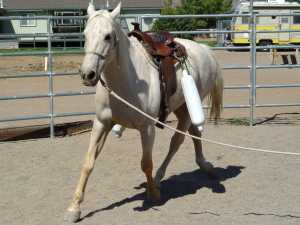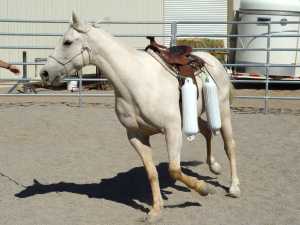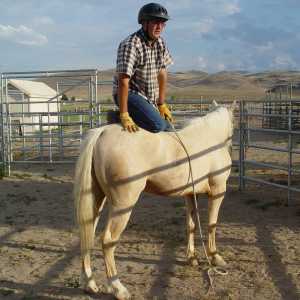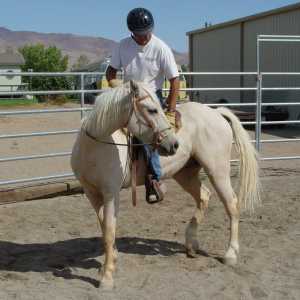Using Boat Bumpers
|
Two bumpers on one side
|
|
Once the horse is settled with respect to packing the bumpers we'll change their location, put two on one side, then two on the other, put two on both sides, add simple obstacles such as ground poles to focus the horse's concentration, etc. We want the horse to get used to a number of permutations of these bumper drills and not bore him to sleep by repeating the same thing over and over once he is used to it.
Next we'll have the horse wear a saddle and attach the bumpers. We often start by placing the bumpers behind the stirrups so the horse will feel them. Then we'll move them forward. If the horse is doing well, we'll "ride double" by hanging one set of bumpers over the stirrups and another set behind the first pair. The horse should comfortably work through the various longeing maneuvers and not be distracted by the appearance and feel of the bumpers. Please note the following safety issues.
|
Bumpers on the saddle
|
|
Once we've completed these exercises we still want to engage in our traditional "pre flight checks" before mounting up and asking the horse to deal with all the stimulation involved with packing a rider.
However if we desensitize our horses in ways that develop confidence and trust, we have a greater probability that our animals will accept and be comfortable with whatever it is that we ask of them, so long as what we ask is reasonably sensible. |
Slapping the stirrups
|
Moving to the next level
|
The ultimate objective
|
Return to Part One
See our feature -
Training Horses the Wal-Mart Way
Training Horses the Wal-Mart Way
|
Important Note: If you take on the project of developing an untrained horse, everybody will want to give you advice. Don't act on any advice, including the ideas offered in this site, unless it makes sense to you and fits your individual situation. Your abilities and the sensitivities of your horse(s) may differ from the examples given. Be alert and rational with your actions so neither you nor your horse will get hurt. This information is offered as illustrations of what we do and the reader must apply common sense since he or she is solely responsible for his or her actions. Happy trails!Press "Back" to return to the page that brought you hereGo to Case Study SectionReturn to Training SectionReturn to Wild Horse MentorsReturn to KBR World of Wild Horses and BurrosGo To
|







